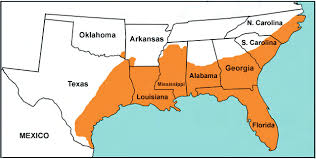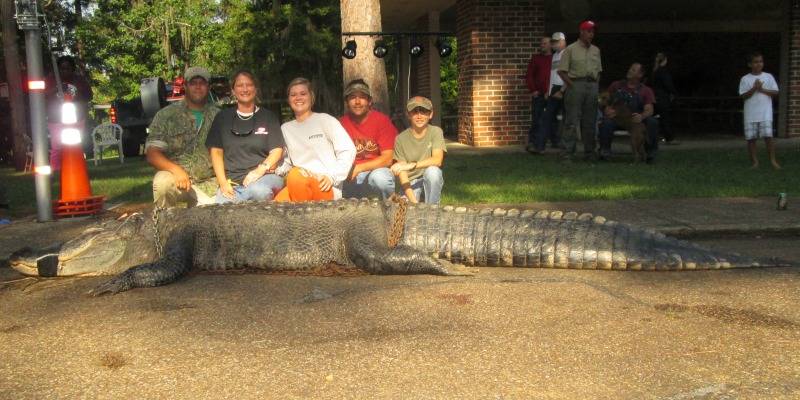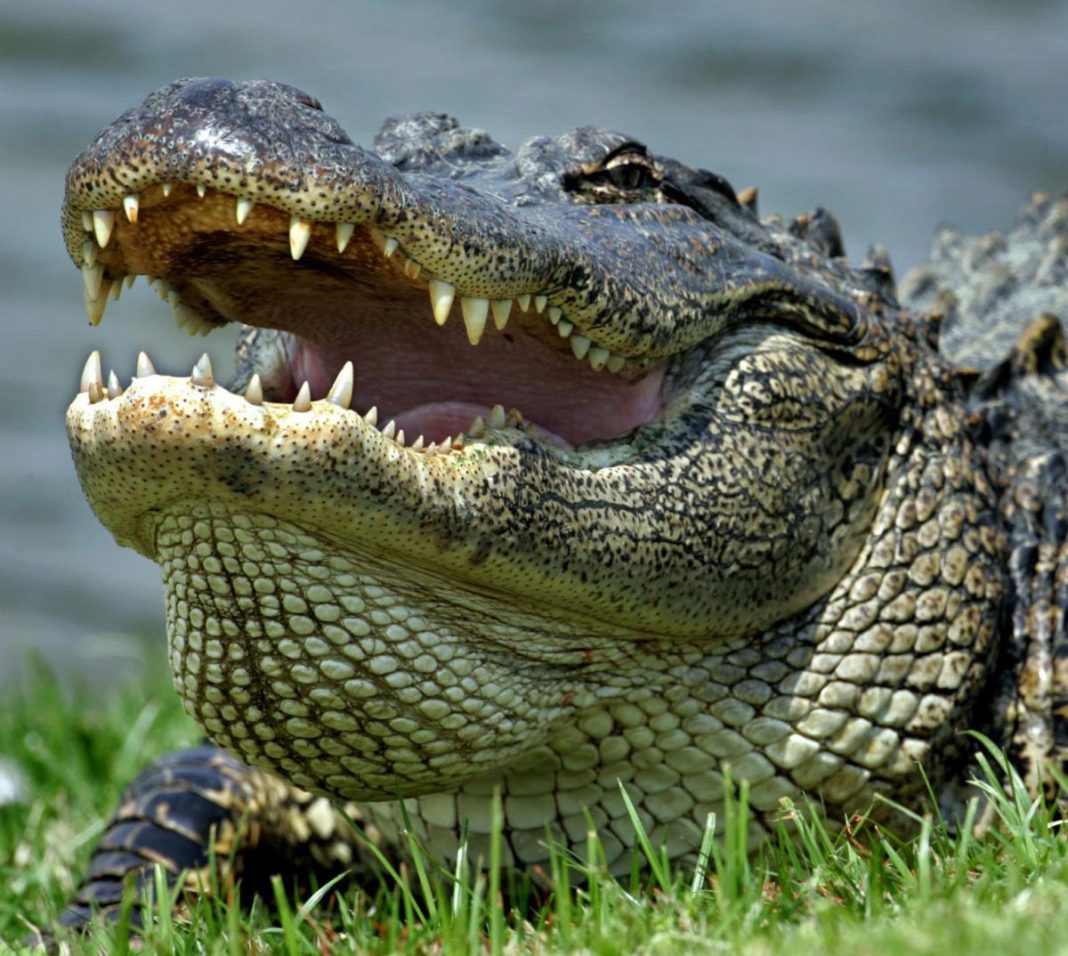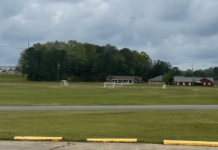Most people don’t know it, but we do have a lottery of sorts in Alabama. This one, though, is for who gets to go ‘gator hunting. American alligators not being on the endangered species list since 1987 doesn’t mean they’re on the eradication list, either. The number of alligators allowed to be taken has steadily gone up since alligator hunting started back in 2006, but only 260 alligator possession tags will be given out this year. The tags are “free,” but getting one is a matter of determination and luck. How does it work? First, some backstory…

Alligator habitat spreads all the way from North Carolina, along the Atlantic coast, consumes Florida as most people know, and continues along the coastal plain of the Gulf of Mexico through Alabama, Mississippi, Louisiana, Texas, and Mexico. Most people don’t think of alligators spreading away from the coastal areas like Mobile county, however. For many years in fact, alligators barely even existed along the coast. Then an effort was made to protect them and bring the gator population back to good health. And boy, did it work. Now they are populous throughout the coastal plain, which actually covers most of south Alabama.
Restoration of the American alligator is a national conservation success story in which Alabama played a lead role. Unregulated alligator harvest throughout the South in the 1920s, 30s and 40s threatened the species with extinction. In 1938, Alabama took action and became the first state to protect them. Other states followed our lead and, in 1967, the U.S. Fish & Wildlife Service placed the American alligator on the Endangered Species List. Two decades of protection enabled the species to rebound. By 1987, it was removed from the Endangered Species List but retained as a federally protected species.
Alabama’s alligator population has grown to the extent that they pose a nuisance in many areas. Implementing a regulated alligator hunt on a small scale is an important step toward controlling populations and better managing this unique reptile.
— https://www.outdooralabama.com/alligators/alligator-hunting-season-alabama
The new era of alligator hunting in Alabama kicked off in 2006, with hunters across the state scrambling to get a shot at bagging one of the first gators legally taken in Alabama in decades. Frustration sounded, however, when the tag lottery was announced. The random tag distribution hasn’t changed in the 13 years since, but a points system gives some hope for those determined enough to keep applying every year.
In 2006, Alabama opened its first alligator season in nearly 70 years. During the initial season, 46 Alabama hunters including five women bagged 40 gators. The reptiles ranged in size from 7 feet, 7 inches to 12 feet, 4 inches. The biggest one weighed 461 pounds. — alabamaliving.coop/article/alligators-make-remarkable-recovery
Since then, there have been some bigger boys bagged. Such as this monster:

So what is the “tag lottery” process? For each of the zones you would like to apply to hunt, you must pay $22 for an administrative fee. You can apply to all five zones. The trick here is that if you get a tag through random selection (again, a points system can give some people an advantage), you are only allowed one tag. One person, one tag. Period. If you get a tag in more than one zone that you’ve applied to hunt, you must pick one and give the other(s) back to be distributed to runners-up. Luckily there is a whole additional zone available this year. From Outdoor Alabama:
“Hunting zones, total tags issued per zone and hunt dates are as follows:
SOUTHWEST ALABAMA ZONE – 100 Tags
Locations: Private and public waters in Baldwin and Mobile counties north of interstate 10, and private and public waters in Washington, Clarke and Monroe counties east of U.S. Highway 43 and south of U.S. Highway 84. 2019 Dates: Sunset on August 8, until sunrise on August 11. Sunset on August 15, until sunrise on August 18.
COASTAL ZONE – 50 Tags
Locations: Private and public waters in Baldwin and Mobile counties south of Interstate 10. 2019 Dates: Sunset on August 8, until sunrise on August 11. Sunset on August 15, until sunrise on August 18.
SOUTHEAST ALABAMA ZONE – 40 Tags
Locations: Private and public waters in Barbour, Coffee, Covington, Dale, Geneva, Henry, Houston and Russell counties (excluding public Alabama state waters in Walter F. George Reservoir/Lake Eufaula and its navigable tributaries). 2019 Dates: Sunset on August 10, until sunrise on September 2.
WEST CENTRAL ALABAMA ZONE – 50 Tags
Locations: Private and public waters in Monroe (north of U.S. Highway 84), Wilcox and Dallas counties. 2019 Dates: Sunset on August 8, until sunrise on August 11. Sunset on August 15, until sunrise on August 18.
LAKE EUFAULA ZONE – 20 Tags
Locations: Public state waters only in the Walter F. George Reservoir/Lake Eufaula and its navigable tributaries, south of Alabama Highway 208 at Omaha Bridge (excludes Eufaula National Wildlife Refuge). 2019 Dates: Sunset August 16, until sunrise September 30.
Each person receiving an Alligator Possession Tag will be allowed to harvest one alligator during the season. An 8-foot minimum length requirement is in effect for alligators harvested in the Lake Eufaula Zone. There is no minimum length for hunts in the other zones. The use of bait is prohibited.”
Applicants may register at Alabama Department of Conservation and Natural Resources
Alligator Hunt website by clicking the link here.
Registration begins at 8:00 AM CDT on June 4, 2019, and ends at 8:00 AM CDT on July 10.
Selections for each zone will be held at 12:00 PM CDT on the second Wednesday of July. Selection results will be posted immediately thereafter and applicants can check their selection status on the same website in which they registered.
Only persons eligible to hunt as residents of the State of Alabama who are 16 years of age or older or current holders of an Alabama Lifetime Hunting License may apply for an Alligator Possession Tag. Non-residents may only participate as alligator hunting assistants.
All alligator hunters given tags MUST take a special Alligator Training Course before they will be allowed to hunt. The courses are at specified dates and locations, so check the site when applying.

Another aspect of legal alligator hunting in Alabama that could surprise some is the method that must be used. The gator must be captured before being dispatched (killed). No shots with a rifle from across a pond, as we’ve seen on the “Swamp People” television show. You must wrangle it along side your boat before using only a shotgun or stick gun of specified caliber or gauge to put it down, otherwise you must release it immediately. In other words, wear your big-boy (or big-girl) pants and take some extra T.P. in case a scaly hoss gets too frisky when you try to make him hug your flat-bottom boat.
Still think you could hang with “Shelby the Swamp Man?” Give it a try, and good luck in the lottery.

















